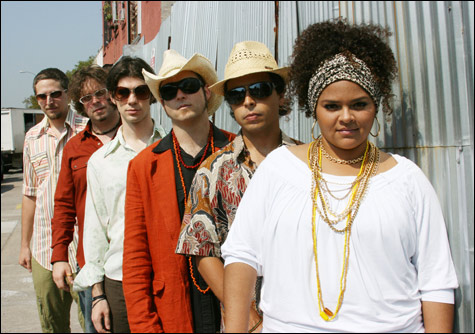
ROOTED On Legends of the Preacher, Nation Beat create their own folklore. |
Fusions are the lifeblood of music, but too often they come with a whiff of high-concept gimmickry. Country rock, folk rock, cowpunk, Latin jazz — all well and good. But when does an integral style break down? At what point do the signifying regionalisms and musical accents get whirled and blended at such a high velocity that you end up with music that sounds as if it were from — nowhere? In his more purist jazz moments, Wynton Marsalis has drawn an analogy with gumbo: at what point does it become just soup with shrimp?
Not that music has to be of an identifiable genre to be good. (Most of the time the opposite is true — or else genre becomes generic.) But it does have to be identifiable as something, its own integral self and not just a collection of musical signifiers. Or, as the resolutely free-improv saxophonist David Gross once said to me mockingly: “I’m going to have my Latin-country-funk band. . . . This is my orchestral dub ensemble.’ ”

And yet, in town over the past couple of weeks we’ve had Dengue Fever, a Los Angeles Cambodian-American psych-surf band, and Forro in the Dark, Brazilian Brooklyners who meld South American rhythms with reggae, among other things. Now we have Nation Beat, yet another Brooklyn band, coming to the Regattabar on June 31. On their new Legends of the Preacher (Modiba), you can hear their core sound — the maracatu rhythms of the Northeast Brazilian city of Recife (home also to forró) — wed to zydeco, New Orleans funk, bluegrass, country (Hank’s “I’m So Lonesome I Could Cry” is here, and so is “Blue Eyes Crying in the Rain”) and, gulp, klezmer. All three of these bands make integral music that reaches wide with obvious references yet still holds together as its own thing. And they do it in different ways.
You can get away with a lot in folkloric music if your folklore is sound, and Nation Beat (terrible band name aside) have done their homework. Scott Kettner, a young jazz percussionist in New York, was encouraged to study maracatu by his teacher, the great jazz drummer Billy Hart: “I don’t know how to play it, but it’s a bad-ass rhythm and you gotta learn it so you can teach it to me!”
Kettner studied for a year in Recife with the maracatu master Jorge Martins (who appears as a guest on Legends of the Preacher). Here’s part of what he discovered: the maracatu rhythm dates back about 400 years — it’s far older, and more African, than forró. It’s drawn from the “crowning ceremonies” that African slaves developed in Brazil under Portuguese rule, a mix of African and Portuguese traditions. “After the crowning ceremony,” Kettner tells me over the phone from Brooklyn, “they would have a celebration where they would sing, dance, and play drums, and out of those celebrations evolved this cultural manifestation known as maracatu.” The ceremonies became entertainments for the Portuguese rulers, but as they imitated Portuguese royalty, they also mocked it, a coded minstrelsy that allowed the ceremonies to continue.
The crowning ceremonies are still going on, but they’ve shifted from patriarchal to matriarchal — from king to queen. The celebrations can include as many as 150 drummers and percussionists, just as many dancers, and a complete royal court.
This ritual will ring a bell for anyone familiar with the Mardi Gras Indian tribes of New Orleans, with their Big Chiefs, elaborate ritualized performances, and community authority. Kettner confirms the similarity: “Each neighborhood has its own maracatu group, each with its own queen, and the queen does have an authority over that community.”
The rhythm itself cuts deep bass drum with snare and bells in a driving, polyrhythmic 4/4. Kettner’s band Maracatu New York stick purely to percussion, but on Legends of the Preacher Nation Beat went for the fusion of Brazil with New Orleans and the American South, so the first thing to hit you on the first track, “A Onde Tem Cerveja Tem Mulher” (“Wherever There Is Beer There Are Women”), is Skye Steele’s slashing country fiddle and Eduardo Guedes’s ringing triangle over the maracatu drum beat, sounds that bring you right into zydeco territory.
The fusion — “the Mississippi and Capibaribe” (the river that runs through Recife) — came about as Kettner and Martins played records for each other and noticed similarities. On Legends of the Preacher, the maracatu rhythms seem able to hold everything: accordion continues to make the Cajun country connection, but on “Nagô Nagô,” the fiddle comes in on top of a very urban funk guitar riff that later breaks for Raphael McGregor’s “sacred” lap steel and one of the purest of the record’s maracatu call-and-response group vocal chants with lead singer Liliana Araújo.